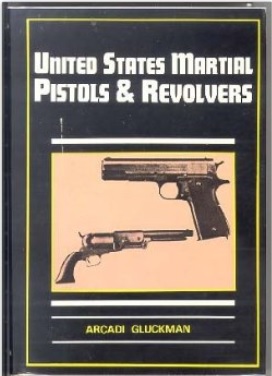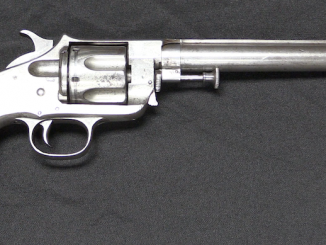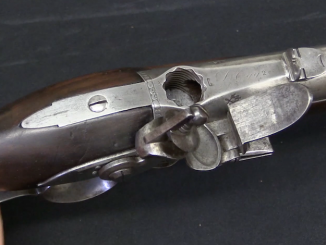 Pre-WWI American handguns are an area that I am pretty weak in, and I’m working to remedy that. One of the initial resources I picked up was Arcadi Gluckman’s United States Martial Pistols and Revolvers
Pre-WWI American handguns are an area that I am pretty weak in, and I’m working to remedy that. One of the initial resources I picked up was Arcadi Gluckman’s United States Martial Pistols and Revolvers. Originally printed in 1939, it is a pretty good reference for the title subject – especially considering the price.
Arcadi Gluckman was a retired Colonel of the US Army, and an avowed “gun crank” (“gun nut,” we would say today) who saw a need for a good reference on American military handguns and decided to write it himself. The result was a remarkably well rounded book – each chapter includes some initial historical context, the relationship between the government and the various arms manufacturers, and then detailed information on each firearm, including dimensions and markings. The book was reprinted without significant changes through the 1960s – my 1977 copy of Flayderman’s Guide refers to it as “the basic guidebook to the field.”
The biggest shortcoming is the illustrations. The book contains 29 photographic plates (all at the end), each showing four to six different pistols. Each pistol is presented only once, so you never get to see both sides, and the pictures are black and white and fairly small. It is only because of the quality of the gun descriptions that the poor photographs are not a hindrance in trying to identify a particular piece.
The book is divided into two parts – single shot pistols and repeaters. The single shot section is further divided into chapters on flintlocks, percussion pistols, cartridge pistols, and secondary martial pistols. The first three of those are obvious (and the single shot cartridge pistol chapter is quite short, containing just three Remingtons and a single Springfield experimental model), but the fourth is worth explaining. Gluckman defines primary martial pistols as ones which were made by government arsenals or under major contract for standard issue to military forces. That, of course, leaves a great many designs made in much smaller numbers on emergency contracts, in hope of military sale, or for individual states or militias – those are the secondary martial pistols. While not of the large-scale historical importance like the standard-issue designs, those secondaries are just as interesting (often more interesting, in my opinion) to the collector and scholar. Gluckman includes more than 40 of these secondary single shot designs, including ones like the Hall breechloading pistols (both bronze and iron) and Lindsay two-shot percussion pistol. The information presented on the secondary guns is, understandably, much less detailed than that on the primary issue models.
The second section of the book, as I said, covers repeaters – revolvers and semiautomatic handguns. Let me begin by touching on the semiauto chapter. It is short, perfunctory, and really of minimal value. It has one short page each on the Grant-Hammond and Savage (more information on both is readily available on the ‘net today), and nothing on the Remington M53. The sections on the Colt 1902 and 1911 are fine, but today there are a plethora of outstanding resources on these (and the other Colt automatic variants), and Gluckman has nothing to add to them. And that’s fine, really – the reason to have this book is for its coverage of the older guns, not the semiautos.
There are two chapters on revolvers, splitting them between percussion guns and cartridge guns. The major designs (Colt and S&W) have a fair bit of information, while most of the others (several dozen of them) have about a page each. As with the first section of the book, each of those entries include mechanical specifications as well as typical markings.
Overall, I find United States Martial Pistols and Revolvers to be a good introductory reference to its subject. It provides a very useful overview of the pistol development and military use in the United States, which can be then followed up with more detailed research on individual makes and models. Without a high-altitude overview like Gluckman’s, it is difficult to know where to begin on the subject, and how much significance each particular gun should be credited with. The best part is that while it is long out of print today, there are plenty of copies available on Amazon as cheap as $5 plus shipping. At that price, there is absolutely no reason not to add this volume to your library.




It is a mystery why it took so long to develop a transfer bar system to a revolver.
No one wants anyone or horse shot if a handgun falls out of a holster, and why would anyone want to leave the hammer down on an empty chamber, thus turning a six shooter into a five?
Well, Iver Johnson patented the Fyrberg transfer bar safety for revolvers in 1896;
http://www.guns.com/wp-content/uploads/2013/04/fryberg_safety_auto_transfer_bar_patent-1.jpg
But they only applied it to small-to-medium caliber pocket and “house” revolvers. By the time anyone thought of applying it to a full-grown service revolver, the revolver had been largely superseded by the automatic for military purposes.
It was less that it took so long for it to be thought of than that it was out-evolved by an entirely different OS. Sort of the way Windows did MS-DOS.
😉
cheers
eon
Austrian Gasser 1870
http://www.hungariae.com/Gass70.htm
has safety system so it could be carried fully loaded
Not transfer bar but a lot of European revolvers had rebounding hammers since mid-late 1870s. For one reason or other it never became popular in America until much later. Double action Merwin Hulberts had rebounding hammer, which is probably a first US made revolver with it.
Gassers had own unique safety, just as Daweo noted. Having handled and fired one I must say that safety is really solid and well designed and I would trust it to keep from negligible discharges in case gun gets bumped.
“It is only because of the quality of the gun descriptions that the poor photographs are not a hindrance in trying to identify a particular piece.”
If you want to identify firearm from appearance A.B.Zhuk’s Стрелковое оружие (english version: Encyclopaedia of small arms)
That Remington M53 is interesting, unusual… Usually, you would think of a breech block staying still while the slide moved and in so doing this would allow the block to move. Rather than it moving with the slide, effectively unlocking it for 2mm while delaying this by the slide/blocks mass etc until the block locks. Then the block unlocks from the frame upon further movement of the slide, I think.
Would this minimum amount of movement of the case from the chamber have any effect on the brass, would it expand more or something out of interest?
I say usually you would think, if you were thinking of it…
Wondering if it would aid extraction, or slow the rearward movement even.
It kind of looks, quite slim compared to a 1911 – Thinking of this in regards the weight, slide weight like “resistance” to rearward motion etc, was the unusual method to do with trying to facilitate it’s slide being less chunky type thing.
That HK pistol, with the extra deep rifling trick… Maybe it was intended to lose some gas pressure, to weaken the rearward impetus.
The Remington .45 prototype (aka the M1917) operated on the same retarded-blowback principle as the M51 pocket auto. Both were designed by John D. Pedersen.
The separate breechblock, inherited from the M51, moved back on initial recoil impulse to “break” the cartridge case free of the chamber, to provide relatively easy primary extraction and avoid potential case-head separation. This worked because the .45 ACP is a relatively low-pressure round (21,000 PSI/144,790 kPa), as opposed to the 9 x 19mm or .38 Super Auto(both approx. 35,000 PSI/241,317 kPa).
With higher-pressure rounds, the weapon would very likely have been unsafe for the user.
What did in the M53/1917, however, was that it was a Navy project that was under development when the U.S. suddenly found itself in a war. The War Department concluded that there was no real, compelling reason for the navy to have its own “distinctive” .45 pistol, and production of the M12911 Colt was the primary objective, especially due to the anticipated demand for handguns for trench warfare. As such, the M1917 project was ended, and the Navy (and Marines) were issued the 1911.
History might have been a bit different if the M1917 had been greenlighted for issue, especially to the Corps. Imagine Jeff Cooper extolling the virtues of the sleek, fast-handling .45 Remington over the more “boxy” Colt in the Leatherslaps of the 1950s, and as he developed his “New Technique” thereafter.
cheers
eon
The M53 is only nominally a .45acp perhaps, in some ways i.e. It fires the cartridge at a lower velocity than a 1911 by design, hence the lighter slide less recoil etc. This maybe was a reason why the Army “Jeff Cooper” never took to it, it was slightly under powered on purpose which may have given it some advantages apart from power. The breech slippage might not allow the cartridge case to expand in the chamber properly initially, thus leaking a bit of pressure from the barrel.
It might not do, I am just thinking given it apparently did have a lower velocity in the trials maybe it wasn’t wear and tear – It did have anyway, type of thing.
Out the new R51 model which uses Pedersons breech apparently, the velocity of Cor-bon +p Dpx 115grn is 1177 while it’s listed as being 1250, Fiocchi Fmj 115grn 1260 listing, 1062 out of the R51.
Source:
http://www.ballistics101.com/9mm.php
http://www.gunblast.com/Remington-R51-2.htm
Might be relevant, in the context of losing velocity.
“With higher-pressure rounds, the weapon would very likely have been unsafe for the user.”
Excluding Pedersen’s designs there was also other firearm using hesitation lock, the SIG MKMO sub-machine gun:
http://en.wikipedia.org/wiki/SIG_MKMO_submachine-gun
It was chambered for: 7.65×21 Parabellum (aka .30 Luger) or 9×19 Luger or 7.63×25 Mauser or 9mm Mauser Export (9x25mm Mauser i.e. round in Hungarian Danuvia 39.M sub-machine gun) and so far I know, there was no mechanical issues with SIG MKMO so hesitation lock is also suitable for cartridge with higher pressure than .45 Auto like 9x25mm Mauser. I don’t have pressure figures for 9x25mm Mauser but I’m excepting that pressure is similar or bigger than .38 Super
The Benelli B76 pistol uses a sort of hybrid between the pedersen system and an accelerated mass blowback.
It was designed around 9mmP and .30 Luger, and has a very good reputation.
http://world.guns.ru/handguns/hg/it/benelli-b76-e.html
I’d better add that the Pedersen system isn’t a simple trade off between mass and velocety. In many ways it is analagous to a locked breech gas operated system, using the cartridge case and bolt like a Carbine Williams short stroke gas system.
The difficult part is maintaining the correct initial travel for the bolt over the life of the gun.
In fact Pedersen principle of operation is hard to absolute classification and hard to describe. Note that Pedersen’s US Patent 1,348,733:
http://pdfpiw.uspto.gov/.piw?Docid=01348733&homeurl=http%3A%2F%2Fpatft.uspto.gov%2Fnetacgi%2Fnph-Parser%3FSect1%3DPTO1%2526Sect2%3DHITOFF%2526d%3DPALL%2526p%3D1%2526u%3D%25252Fnetahtml%25252FPTO%25252Fsrchnum.htm%2526r%3D1%2526f%3DG%2526l%3D50%2526s1%3D1348733.PN.%2526OS%3DPN%2F1348733%2526RS%3DPN%2F1348733&PageNum=&Rtype=&SectionNum=&idkey=NONE&Input=View+first+page
This patent is titled “Autoloading Firearm” so is not only about action but anyway 122 pages, 19 sheets of drawing and 262 patent claims is impressive and this is only one patent for Remington Model 51 when Pedersen get over 30 patents for his firearm according to unblinkgeye site
I’m wondering about the reference to the “Springfield experimental” single-shot metallic-cartridge pistol. According to Charles Edward Chapel, in U.S. Martial Single-Shot Pistols (1956), the “Springfield Trapdoor” pistol was a fake, created to fleece gullible collectors.
Did Gluckman get taken in by it? Or was there an actual, different Springfield single-shot prototype?
cheers
eon
http://milpas.cc/rifles/ZFiles/Single%20Shot%20Cartridge%20Rifles/U.S.%20SPRINGFIELD%20TRAPDOOR%20RIFLE/U.S.%20SPRINGFIELD%20TRAPDOOR%20RIFLE.htm
states that:
“There are a number of non-armory produced pistols available that look very similar to the ones that Springfield produced. Typically they were constructed from .50 and .45 caliber parts. Some were produced for the movie industry and some for “other” reasons. The only two Springfield made .50 caliber trapdoor pistols reside in museums: the Smithsonian and the Springfield Armory museum.”
so I think that you would check the pistols in the Smithsonian and the Springfield Armory museum
When watching tmcwestern on cable the movie Brave Warrior came on.http://www.tcm.com/tcmdb/title/69592/Brave-Warrior/ . It was about Good indians vrs Bad indians good US soldiers vrs bad British fighting over the town of Tippecanoe when Indiana Was the WEST. The Soldiers used converted trapdoor pistols and rifles made up to look like Flintlocks! It was funny that all reloading was done off camera. Every time the hero holds his Flint lock-trapdoor pistol he had to wrap his hand around the barrel to cover the obvious trapdoor. Stembridge Gun rentals must have made these pistols up. Were they sold when the Stembridge sold off all their guns?